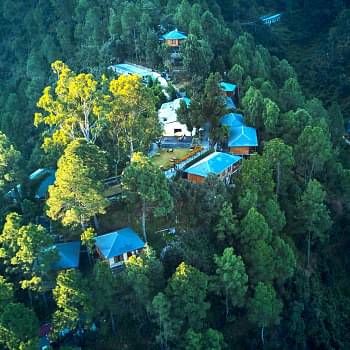May 14, 2020
How to Reach Hampi and What to Do There: A Guide

Nikita


View all
140+
Resorts

View all
2000+
Experiences
'Only At Club Mahindra' Experiences
May 14, 2020

Nikita
You are one of many travellers who are curious about how to reach Hampi. That’s because the place is so amazing, people are anxious to experience it.
If you are a lover of art and/or history, then a visit to Hampi should figure on your list of must-things to do this year. You could be planning a short getaway with your partner, or an annual trip with your family. Give Hampi a try – you will love the experience and want to visit again!
Here’s a detailed guide on how to reach Hampi by flight, train and road. It also covers what you can do there.
There are a number of ways if you wish to know how to reach Hampi. You can reach Hampi by:
The nearest airport to Hampi is at Belgaum, which is closer to the Maharashtra-Karnataka border and located about 270 km away. If your flight lands at Bengaluru, then you have a big drive of 300 km to complete before you reach Hampi. However, most flights from the Indian metros and bigger cities land in Bengaluru. So, you should look for a connection to Belgaum airport.
Hampi does not have a rail head, but the nearest terminal is at Hospete located about 13 km away. It is well connected to different cities of the country, so knowing how to reach Hampi is easy enough once you alight here – just take a bus or a cab to your Hampi resort. As of now, there are 10 daily trains arriving at Hospete and 5 Express trains plying thrice a week.
Bangalore and other cities in Karnataka (such as Belgaum) are well-connected to Hampi. You can find a lot of KSRTC buses going to Hampi from within Karnataka. Look up updated Hampi tourism guides for the routes.
You can also drive down to Hampi. Here’s how to reach Hampi if you are planning a road trip.
|
From City |
Route Description |
Distance (Approx.) |
Travel Time (Approx.) |
|
Bangalore |
NH48 to Tumakuru, then NH50 towards Chitradurga, and from there to Hospet. Hampi is a short drive from Hospet. |
340 km |
6 to 7 hours |
|
Hyderabad |
NH44 south to Kurnool, switch to NH40 towards Gooty, then towards Bellary and Hampi. |
380 km |
7 to 8 hours |
|
Mumbai |
NH48 to Pune, NH52 towards Solapur, NH65 towards Hyderabad, then off towards Hampi via Raichur and Gangavathi. |
720 km |
12 to 14 hours |
|
Goa |
NH748 to NH52 towards Hubli, NH67 towards Gadag, then local roads towards Hospet and Hampi. |
350 km |
7 to 8 hours |
|
Chennai |
NH48 towards Bangalore, then follow the Bangalore to Hampi route. |
570 km |
10 to 12 hours |
Now that you know how to reach Hampi, let’s take a look at what to do there.
The Hampi ruins are spread over a huge 16 square miles of land, making it one of the ancient marvels still present in the modern world. The overall site is said to have over 1,600 remains that symbolise the Hindu Vijayanagara kingdom, which was very powerful in the South. Here’s why you must visit Hampi with your family:
Hampi is a living mass of structures, albeit in ruin form, in front of your eyes. It is like literally walking through history, which you might not be able to do elsewhere in the country. The ruins are the most important place to visit in Hampi simply because of the sheer lesson in ancient history and politics it gives us. Be sure to take your children along so that they may know more about this ancient wonder from a faraway time.
The ruins are a perfect embodiment of an ancient city halted in its tracks by plunder and destruction. You can clearly see the outlines and structures of temples, sacred prayer rooms and halls, shrines, pillared meeting halls, memorials, stepwells and water storage structures, forts, riverside steps, temple mandapas, and so on. Walking alongside the ruins in silence will almost make you believe that you can see the ancient city in front of your eyes, with its grand designs and daily bustle.
The famous Virupaksha Temple is still used in Hampi. Praying at the temple is one of the most important things to do in Hampi. This is because the temple and the famous Hemakuta Hill are said to be devoted to Goddess Parvati, who won over Lord Shiva (as he meditated) by practising an austere life like him. The area attracts a lot of Shiva worshippers annually, especially during Shivratri.
Let’s now get you started on making a list of tourist spots to visit during your Hampi holiday. Hampi tourism lists the following must-visit places (they are all open from 6 am to 6 pm on all days, barring certain Government holidays that the Karnataka State follows)
Lord Virupaksha is considered to be an incarnation of Lord Shiva. This temple is a huge edifice that is visited by Shiva devotees from all over the country. It is reportedly one of the oldest temples in Indian history, but it is still fully functional and quite in use. The temple was said to be constructed in the 7th Century. The complex has old structures (probably houses or prayer rooms for priests), a large courtyard in the centre, large towers in the corners, and so on. There are guides on hand to explain the different parts of the temple and what goes on there.
Just like the Lord Virupaksha Temple, the Hemakuta Hill Temple Complex is another famous temple that is certainly worth a visit. It is situated on top of the magnificent Hemakuta Hill, comprising many ruined walls, pathways that now lead to nowhere, and many temples of varying sizes. The temple complex is located just outside Hampi, and is known for the panoramic views of the adjoining areas. You will love the sunsets from here, as also a visit to the Mula Virupakshi Temple inside the complex.
Hampi is known as a site dedicated to the service and worship of Lord Shiva. So it is only fitting that there is a collection of 108 Shiva lingas carved on the flat rocky surfaces among the ruins. Along the riverside, there is a large rock carving of Lord Vishnu seen reclining. The carvings are in great condition, and provide excellent backdrops for your photographs.
How is it possible that Hampi would not have a museum to its name? In fact, it has a wonderful one – do visit the Archaeological Museum here in Kamlapur. It is located just a few kilometres outside Hampi, and has ancient artefacts, paintings and carvings. You will especially love their collection of old coins and armoury that was used in various wars.
As the name suggests, this was a secluded bathing area for the king and his wives. It most probably housed a large pool that was cut off from the rest of the palace, and provided isolation to the ruler and his consorts. The design of the pool is intricate and has a (partially ruined) domed roof. There are balconies outside seating platforms, with small windows to look out from. The pool is set in a rectangle in the centre of the structure, with an opening in the dome so that the sky could be seen while bathing. An interesting aside here is that you can buy some stone carvings made by local artisans just outside this site, which make for great curios and mementos to take back home.
Located at Hospet, the Tungabhadra Dam supplies drinking water to Hampi, irrigation water for the area’s farmlands and also assists in controlling flooding during the monsoon season. The dam is built across one end of the famous Tungabhadra River, and has lush gardens on either side.
Hampi also has a wonderful sanctuary, the Daroji Bear Sanctuary. You can see a lot of Indian wildlife here, from deer to leopards, and from sloth bears to hyenas. This sanctuary is probably the only one to have sloth bears in all of India. Arm yourself with a bottle of water – it is a long walk inside the sanctuary – and a pair of strong walking shoes before you set out. The best time to visit Hampi’s prized sanctuary is the winter season, when many migratory birds can also be spotted here.
You will find all of the popular Indian cuisines here, from Mughlai to Gujarati and South Indian preparations. But if you want a taste of authentic local fare, try these: potato curry, poppadums, curried rice and mutton cutlets in red sauce. Many popular restaurants in Hampi serve authentic Karnataka fare, so dig in!
As regards shopping, you can buy leather bags and shoes, original Lambani artefacts, stone artefacts, banana fibre items, and even second hand musical instruments.
Now that you have got an idea of how to reach Hampi and what to see and do there, it is time to book your Hampi resort. Picking a resort will enrich your holiday, instead of a cheaper homestay or home rental where you are expected to provide for yourself.
We recommend staying at the Club Mahindra Vijayashree Resort and Heritage Village at Hampi. True to the purity and spirit of Hampi, the resort is designed along the ancient Ayurvedic ‘panch bhuta’ philosophy, which insists on simple and sattvic living. Accordingly, the resort offers pure vegetarian meals and does not serve alcohol. You are also not allowed to smoke on the premises. The theme of sattvic life is taken forward in the cosy rooms and warm hospitality. You will love the 20 acres of sprawling property offering peace, greenery and serenity outside the city chaos.
FAQs
Q: How do I get to Hampi by bus?
You can get a KSRTC bus to Hampi, from many destinations from within Bengaluru. Go to Bengaluru from your hometown, either by train or flight, and then catch a bus. The closest to Hampi is Hospete city, about 13 km away.
Q: How do you travel inside Hampi?
You can rent a bike if you are travelling alone or with your partner. If you are travelling with your family, ask your resort to book a car for you.
Q: Is Hampi worth visiting?
Hampi is certainly worth visiting if you like history and are interested in ancient Indian civilisations. The ruins are a testament to the glories of the ancient Vijayanagara Empire, so brush up on your information before you go.
Q: Where should I stay when visiting Hampi?
We recommend the Club Mahindra Vijayashree Resort and Heritage Village at Hampi. It is built on the principles of good living via Ayurveda and a clean lifestyle. You will love the vegetarian menu, the tastefully designed rooms and the vast 20 acres of greenery on the property.
Q: How many days do you need in Hampi?
About 4 days should be sufficient to visit all of Hampi’s tourist hotspots, shop, eat at the popular restaurants and relax.
Mahindra Holidays & Resorts India Ltd. (MHRIL), a part of Leisure and Hospitality sector of the Mahindra Group, offers quality family holidays primarily through vacation ownership memberships and brings to the industry values such as reliability, trust and customer satisfaction. Started in 1996, the company's flagship brand ‘Club Mahindra’, today has over 290,000 members , who can holiday at 140+ resorts in India and abroad.